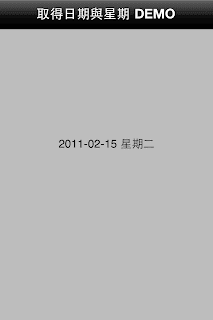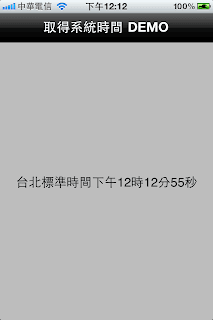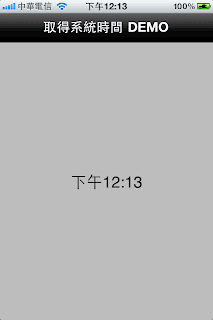NSDate,NSCalendar,NSTimer,NSTimeZone
NSDate存储的是世界标准时(UTC),输出时需要根据时区转换为本地时间
Dates
NSDate类提供了创建date,比较date以及计算两个date之间间隔的功能。Date对象是不可改变的。
如果你要创建date对象并表示当前日期,你可以alloc一个NSDate对象并调用init初始化:
- NSDate *now = [[NSDate alloc] init];
或者使用NSDate的date类方法来创建一个日期对象。如果你需要与当前日期不同的日期,你可以使用NSDate的 initWithTimeInterval...或dateWithTimeInterval...方法,你也可以使用更复杂的calendar或 date components对象。
创建一定时间间隔的NSDate对象:
- NSTimeInterval secondsPerDay = 24 * 60 * 60;
- NSDate *tomorrow = [[NSDate alloc] initWithTimeIntervalSinceNow:secondsPerDay];
- NSDate *yesterday = [[NSDate alloc] initWithTimeIntervalSinceNow:-secondsPerDay];
- [tomorrow release];
- [yesterday release];
使用增加时间间隔的方式来生成NSDate对象:
- NSTimeInterval secondsPerDay = 24 * 60 * 60;
- NSDate *today = [[NSDate alloc] init];
- NSDate *tomorrow, *yesterday;
- tomorrow = [today dateByAddingTimeInterval: secondsPerDay];
- yesterday = [today dateByAddingTimeInterval: -secondsPerDay];
- [today release];
如果要对NSDate对象进行比较,可以使用isEqualToDate:, compare:, laterDate:和 earlierDate:方法。这些方法都进行精确比较,也就是说这些方法会一直精确比较到NSDate对象中秒一级。例如,你可能比较两个日期,如果他 们之间的间隔在一分钟之内则认为这两个日期是相等的。在这种情况下使用,timeIntervalSinceDate:方法来对两个日期进行比较。下面的 代码进行了示例:
- if (fabs([date2 timeIntervalSinceDate:date1]) < 60) ...
NSCalendar & NSDateComponents
日历对象封装了对系统日期的计算,包括这一年开始,总天数以及划分。你将使用日历对象对绝对日期与date components(包括年,月,日,时,分,秒)进行转换。
NSCalendar定义了不同的日历,包括佛教历,格里高利历等(这些都与系统提供的本地化设置相关)。NSCalendar与NSDateComponents对象紧密相关。
你可以通过NSCalendar对象的currentCalendar方法来获得当前系统用户设置的日历。
- NSCalendar *currentCalendar = [NSCalendar currentCalendar];
- NSCalendar *japaneseCalendar = [[NSCalendar alloc] initWithCalendarIdentifier:NSJapaneseCalendar];
- NSCalendar *usersCalendar = [[NSLocale currentLocale] objectForKey:NSLocaleCalendar];
usersCalendar和currentCalendar对象是相等的,尽管他们是不同的对象。
你可以使用NSDateComponents对象来表示一个日期对象的组件——例如年,月,日和小时。如果要使一个NSDateComponents对象 有意义,你必须将其与一个日历对象相关联。下面的代码示例了如何创建一个NSDateComponents对象:
- NSDateComponents *components = [[NSDateComponents alloc] init];
- [components setDay:6];
- [components setMonth:5];
- [components setYear:2004];
- NSInteger weekday = [components weekday]; // Undefined (== NSUndefinedDateComponent)
要将一个日期对象解析到相应的date components,你可以使用NSCalendar的components:fromDate:方法。此外日期本身,你需要指定NSDateComponents对象返回组件。
- NSDate *today = [NSDate date];
- NSCalendar *gregorian = [[NSCalendar alloc] initWithCalendarIdentifier:NSGregorianCalendar];
- NSDateComponents *weekdayComponents = [gregorian components:(NSDayCalendarUnit | NSWeekdayCalendarUnit) fromDate:today];
- NSInteger day = [weekdayComponents day];
- NSInteger weekday = [weekdayComponents weekday];
同样你也可以从NSDateComponents对象来创建NSDate对象:
- NSDateComponents *components = [[NSDateComponents alloc] init];
- [components setWeekday:2]; // Monday
- [components setWeekdayOrdinal:1]; // The first Monday in the month
- [components setMonth:5]; // May
- [components setYear:2008];
- NSCalendar *gregorian = [[NSCalendar alloc] initWithCalendarIdentifier:NSGregorianCalendar];
- NSDate *date = [gregorian dateFromComponents:components];
为了保证正确的行为,您必须确保使用的组件在日历上是有意义的。指定“出界”日历组件,如一个-6或2月30日在公历中的日期值产生未定义的行为。
你也可以创建一个不带年份的NSDate对象,这样的操作系统会自动生成一个年份,但在后面的代码中不会使用其自动生成的年份。
- NSDateComponents *components = [[NSDateComponents alloc] init];
- [components setMonth:11];
- [components setDay:7];
- NSCalendar *gregorian = [[NSCalendar alloc] initWithCalendarIdentifier:NSGregorianCalendar];
- NSDate *birthday = [gregorian dateFromComponents:components];
下面的示例显示了如何从一个日历置换到另一个日历:
- NSDateComponents *comps = [[NSDateComponents alloc] init];
- [comps setDay:6];
- [comps setMonth:5];
- [comps setYear:2004];
- NSCalendar *gregorian = [[NSCalendar alloc] initWithCalendarIdentifier:NSGregorianCalendar];
- NSDate *date = [gregorian dateFromComponents:comps];
- [comps release];
- [gregorian release];
- NSCalendar *hebrew = [[NSCalendar alloc] initWithCalendarIdentifier:NSHebrewCalendar];
- NSUInteger unitFlags = NSDayCalendarUnit | NSMonthCalendarUnit | NSYearCalendarUnit;
- NSDateComponents *components = [hebrew components:unitFlags fromDate:date];
- NSInteger day = [components day]; // 15
- NSInteger month = [components month]; // 9
- NSInteger year = [components year]; // 5764
历法计算
在当前时间加上一个半小时:
- NSDate *today = [[NSDate alloc] init];
- NSCalendar *gregorian = [[NSCalendar alloc] initWithCalendarIdentifier:NSGregorianCalendar];
- NSDateComponents *offsetComponents = [[NSDateComponents alloc] init];
- [offsetComponents setHour:1];
- [offsetComponents setMinute:30];
- // Calculate when, according to Tom Lehrer, World War III will end
- NSDate *endOfWorldWar3 = [gregorian dateByAddingComponents:offsetComponents toDate:today options:0];
获得当前星期中的星期天(使用格里高利历):
- NSDate *today = [[NSDate alloc] init];
- NSCalendar *gregorian = [[NSCalendar alloc] initWithCalendarIdentifier:NSGregorianCalendar];
- // Get the weekday component of the current date
- NSDateComponents *weekdayComponents = [gregorian components:NSWeekdayCalendarUnit fromDate:today];
- /*
- Create a date components to represent the number of days to subtract from the current date.
- The weekday value for Sunday in the Gregorian calendar is 1, so subtract 1 from the number of days to subtract from the date in question. (If today is Sunday, subtract 0 days.)
- */
- NSDateComponents *componentsToSubtract = [[NSDateComponents alloc] init];
- [componentsToSubtract setDay: 0 - ([weekdayComponents weekday] - 1)];
- NSDate *beginningOfWeek = [gregorian dateByAddingComponents:componentsToSubtract toDate:today options:0];
- /*
- Optional step:
- beginningOfWeek now has the same hour, minute, and second as the original date (today).
- To normalize to midnight, extract the year, month, and day components and create a new date from those components.
- */
- NSDateComponents *components = [gregorian components:(NSYearCalendarUnit | NSMonthCalendarUnit | NSDayCalendarUnit) fromDate: beginningOfWeek];
- beginningOfWeek = [gregorian dateFromComponents:components];
如何可以计算出一周的第一天(根据系统的日历设置):
- NSDate *today = [[NSDate alloc] init];
- NSDate *beginningOfWeek = nil;
- BOOL ok = [gregorian rangeOfUnit:NSWeekCalendarUnit startDate:&beginningOfWeek interval:NULL forDate: today];
获得两个日期之间的间隔:
- NSDate *startDate = ...;
- NSDate *endDate = ...;
- NSCalendar *gregorian = [[NSCalendar alloc] initWithCalendarIdentifier:NSGregorianCalendar];
- NSUInteger unitFlags = NSMonthCalendarUnit | NSDayCalendarUnit;
- NSDateComponents *components = [gregorian components:unitFlags fromDate:startDate toDate:endDate options:0];
- NSInteger months = [components month];
- NSInteger days = [components day];
使用Category来计算同一时代(AD|BC)两个日期午夜之间的天数:
- @implementation NSCalendar (MySpecialCalculations)
- -(NSInteger)daysWithinEraFromDate:(NSDate *) startDate toDate:(NSDate *) endDate {
- NSInteger startDay=[self ordinalityOfUnit:NSDayCalendarUnit inUnit: NSEraCalendarUnit forDate:startDate];
- NSInteger endDay=[self ordinalityOfUnit:NSDayCalendarUnit inUnit: NSEraCalendarUnit forDate:endDate];
- return endDay-startDay;
- }
- @end
使用Category来计算不同时代(AD|BC)两个日期的天数:
- @implementation NSCalendar (MyOtherMethod)
- -(NSInteger) daysFromDate:(NSDate *) startDate toDate:(NSDate *) endDate {
- NSCalendarUnit units=NSEraCalendarUnit | NSYearCalendarUnit | NSMonthCalendarUnit | NSDayCalendarUnit;
- NSDateComponents *comp1=[self components:units fromDate:startDate];
- NSDateComponents *comp2=[self components:units fromDate endDate];
- [comp1 setHour:12];
- [comp2 setHour:12];
- NSDate *date1=[self dateFromComponents: comp1];
- NSDate *date2=[self dateFromComponents: comp2];
- return [[self components:NSDayCalendarUnit fromDate:date1 toDate:date2 options:0] day];
- }
- @end
判断一个日期是否在当前一周内(使用格里高利历):
- -(BOOL)isDateThisWeek:(NSDate *)date {
- NSDate *start;
- NSTimeInterval extends;
- NSCalendar *cal=[NSCalendar autoupdatingCurrentCalendar];
- NSDate *today=[NSDate date];
- BOOL success= [cal rangeOfUnit:NSWeekCalendarUnit startDate:&start interval: &extends forDate:today];
- if(!success)
- return NO;
- NSTimeInterval dateInSecs = [date timeIntervalSinceReferenceDate];
- NSTimeInterval dayStartInSecs= [start timeIntervalSinceReferenceDate];
- if(dateInSecs > dayStartInSecs && dateInSecs < (dayStartInSecs+extends)){
- return YES;
- }
- else {
- return NO;
- }
- }
来源:http://blog.csdn.net/lingedeng/article/details/6996599
1、获取当前时间
- NSDateFormatter*formatter = [[NSDateFormatteralloc] init];
- [formatter setDateFormat:@"yyyy-MM-dd hh:mm:ss"];
- NSString *locationString=[formatter stringFromDate: [NSDate date]];
另外的方法:
- -(NSString *)getDate
- {
- NSDateFormatter*formatter = [[NSDateFormatteralloc] init];
- [formatter setDateFormat:@"yyyy-MM-dd EEEE HH:mm:ss a"];
- NSString *locationString=[formatter stringFromDate: [NSDate date]];
- [formatter release];
- return locationString;
- }
//大写的H日期格式将默认为24小时制,小写的h日期格式将默认为12小时
//不需要特别设置,只需要在dataFormat里设置类似"yyyy-MMM-dd"这样的格式就可以了
日期格式如下:
y 年 Year 1996; 96
M 年中的月份 Month July; Jul; 07
w 年中的周数 Number 27
W 月份中的周数 Number 2
D 年中的天数 Number 189
d 月份中的天数 Number 10
F 月份中的星期 Number 2
E 星期中的天数 Text Tuesday; Tue
a Am/pm 标记 Text PM
H 一天中的小时数(0-23) Number 0
k 一天中的小时数(1-24) Number 24
K am/pm 中的小时数(0-11) Number 0
h am/pm 中的小时数(1-12) Number 12
m 小时中的分钟数 Number 30
s 分钟中的秒数 Number 55
S 毫秒数 Number 978
z 时区 General time zone Pacific Standard Time; PST; GMT-08:00
Z 时区 RFC 822 time zone -0800
2、NSTimer定时器的基本操作方式
NSTimer是Cocoa中比较常用的定时器类,基本操作如下:
handleTimer方法可以自行定义。在需要的地方创建timer即可,handleTimer就可以每0.5秒执行一次。
- - (void) handleTimer: (NSTimer *) timer
- {
- //在这里进行处理
- }
- NSTimer *timer;
- timer = [NSTimer scheduledTimerWithTimeInterval: 0.5 target: self selector: @selector(handleTimer:)userInfo: nil repeats: YES];
3、定时器
设置定时器下面显示的定时器将在一秒钟后触发,并一直重复直到定时器被禁用。定时器每次激活时,就会调用发送选择器消息的目标来进行初始化。回调方 法带有一个参数,就是定时器本身.要禁用一个定时器,给它发送invalidate消息,这将释放定时器对象并把它从当前运行循环中删除。
- NSTime *timer ;
- timer = [NSTimer scheduledTimerWithTimeInterval:1.0target:self selector:@selector(handlTimer:) userInfo:nilrepeats:YES];
- - (void)handleTimer:(NSTimer *)timer{
- printf("timer count: %d", count++);
- if(count > 3)
- {
- [timer invalidate];
- }
来源: http://blog.csdn.net/imekong/article/details/7041312
1. 使用 NSTimeZone 取得世界各地时间的方法
下列程式码将示范,如何利用 NSTimeZone 取得世界上已知的时区名称,并且透过这些名称来获得当地时间,如果在系统时间的取得上有任何疑问,可以参考取得 iOS 系统日期与星期的方法一文,其程式码如下。
- //取得目前已知的所有地里名称
- NSArray *timeZoneNames = [NSTimeZone knownTimeZoneNames];
- //取得本地目前时间
- NSDate *date = [NSDate date];
- for(NSString *name in timeZoneNames) {
- NSTimeZone *timezone = [[NSTimeZone alloc] initWithName:name];
- NSDateFormatter *formatter = [[NSDateFormatter alloc] init];
- //设定时间格式
- [formatter setDateFormat:@"YYYY-MM-d HH:mm:ss"];
- //设定时区
- [formatter setTimeZone:timezone];
- //时间格式正规化并做时区校正
- NSString *correctDate = [formatter stringFromDate:date];
- NSLog(@"地点:%@ 当地时间:%@",[timezone name], correctDate);
- [formatter release];
- [timezone release];
- }
由于能取得的地点相当多,下图只是部份的执行结果。

来源: http://furnacedigital.blogspot.com/2011/10/nstimezone.html
2. 取得 iOS 系统日期与星期的方法

在之前的文章中已经说明如何取得 Device 里的 iOS 系统时间,在此将在示范如何使用 NSDate 取得系统的日期与星期,请看以下程式码。
- NSDateFormatter *formatter = [[NSDateFormatter alloc] init];
- NSDate *date = [NSDate date];
- //正规化的格式设定
- [formatter setDateFormat:@"YYYY-MM-dd' 'EEEE"];
- //正规化取得的系统时间并显示
- dateLabel.text = [formatter stringFromDate:date];
当然 NSFormatter 能正规化的格式不只这些,想知道其他的参数可以参考关于 NSDateFormatter 的二三事一文。
3. 取得 iOS 系统时间的方法


如何取得 Device 里的 iOS 系统时间,可以参考以下程式码。
- NSDateFormatter *formatter = [[NSDateFormatter alloc] init];
- NSDate *date = [NSDate date];
- //正规化的格式设定
- [formatter setTimeStyle:NSDateFormatterFullStyle];
- //正规化取得的系统时间并显示
- timeLabel.text = [formatter stringFromDate:date];
- [formatter release];
在时间格式正规化的部份也有多种样式可供选择,其样式如下。
- [formatter setTimeStyle:NSDateFormatterFullStyle];
- [formatter setTimeStyle:NSDateFormatterLongStyle];
- [formatter setTimeStyle:NSDateFormatterMediumStyle];
- [formatter setTimeStyle:NSDateFormatterShortStyle];
最后,如果要让时间与现实时间同步可以考虑实做计时器 Timer 来解决此问题,详细的设定方式可参阅 Timer / 计时器的基本使用方法。
来源:http://furnacedigital.blogspot.com/2011/01/blog-post.html#more
4. Timer / 计时器的基本使用方法


这里介绍 Timer 的基本使用方法,首先设定 Timer 的相关的参数,程式码如下。(View-based Template)
- //自行定义的函式,用来设定使用Timer/计时器的相关参数
- -(void)initializeTimer {
- //设定Timer触发的频率,每秒30次
- float theInterval = 1.0/30.0;
- fpsLabel.text = [NSString stringWithFormat:@"%0.3f", theInterval];
- //正式启用Timer,selector是设定Timer触发时所要呼叫的函式
- [NSTimer scheduledTimerWithTimeInterval:theInterval
- target:self
- selector:@selector(countTotalFrames:)
- userInfo:nil
- repeats:YES];
- }
上述程式码,已经完成 Timer 的基本设定,而下列程式码则是 Timer 触发时所呼叫的函式写法。
- -(void)countTotalFrames:(NSTimer *)theTimer {
- frameCount ++;
- framesLabel.text = [NSString stringWithFormat:@"%d", frameCount];
- }
最后,别忘记在程式进入点这边要呼叫自行定义的 initializeTimer 函式,才能让 Timer 运作。
来源:http://furnacedigital.blogspot.com/2010/11/timer.html
NSDate,NSCalendar,NSTimer,NSTimeZone的更多相关文章
- supersr--时间显示逻辑-->NSDate+NSCalendar
一种:时间逻辑: - (NSString *)created_at{ // 从后台返回的字符串格式:Mon Aug 03 09:17:31 +0800 2014, //NSDateFormatt ...
- Foundation框架下的常用类:NSNumber、NSDate、NSCalendar、NSDateFormatter、NSNull、NSKeyedArchiver
========================== Foundation框架下的常用类 ========================== 一.[NSNumber] [注]像int.float.c ...
- iOS - Swift NSDate 时间
前言 NSDate public class NSDate : NSObject, NSCopying, NSSecureCoding NSDate 用来表示公历的 GMT 时间(格林威治时间).是独 ...
- NSTimer的使用[zhuang]
NSTimer 的头文件 /* NSTimer.h Copyright (c) 1994-2015, Apple Inc. All rights reserved. */ #import <Fo ...
- NSCalendar NSDateComponents
// NSCalendar // 获取当前日历 NSCalendar *calendar = [NSCalendar currentCalendar]; // 获取当前时间日期的各个值 NSDate ...
- iOS CST NSDate
好像是从ios4.1開始[NSDate date];获取的是GMT时间,这个时间和北京时间相差8个小时.下面代码能够解决问题 - (void)tDate { NSDate *date = [NSDat ...
- objective-c常用方法列表(总结)
第1章 Objective-C学习环境准备 1.1 Objective-C基础 1.1.1 Objective-C的发展历程 1.1.2 Objective-C语言的特点 1.1.3 技术架构 1.2 ...
- IOS 类的属性修饰符atomic
在声明一个类的属性时,默认这个属性会被修饰atomic,意思是原子性访问的. nonatomic和atomic修饰的属性,在自己没有重写setter和getter的时候才会发生作用,其主要的作用可以理 ...
- IOS开发 基础框架(Fondation Framework)的线程安全
有一种误解,认为基础框架(Foundation framework)是线程安全的,而Application Kit是非线程安全的.不幸的是,这是一个总的概括,从而造成一点误导.每个框架都包含了线程安全 ...
随机推荐
- 《Effective C++》内存管理
如果global new-hander没有成功配置,会抛出一个std::bad_alloc的exception. #include<iostream> #include<new> ...
- centos 6.5安装esx sdk
1. RHEL 6.3 64 bit yum install e2fsprogs-devel libuuid-devel yum install glibc.i686 yum install perl ...
- 【狼】unity3d iTween插件的学习
之前在一个三消游戏项目中接触到iTween,最近又要用到,发现iTween真的是一个很好用,省事的插件,有很多函数里包括 Hashtable的他都用一个函数很简单的完成了, 举几个例子 void Lo ...
- hdu 4465 Candy(二次项概率)
题目链接:http://acm.hdu.edu.cn/showproblem.php?pid=4465 参考博客:http://www.cnblogs.com/goagain/archive/2012 ...
- Django中的Model(表结构)
Model(表设计) 在这里只提经常用到的三种联表结构: 一对多:models.ForeignKey(其他表) 多对多:models.ManyToManyField(其他表) 一对一:models.O ...
- 安装 PLSQL笔记
安装 PLSQL Developer 1. 下载PLSQL Developer 安装文件.安装文件类型是exe,直接安装就可以. 这个时候打开PLSQL Developer ,打开 help –> ...
- centos下apache thrift的安装
参考:http://running.iteye.com/blog/1983463 thrift-0.9.0安装 最好切换到root用户操作,避免不必要的麻烦. 进行例子程序tutorial目录下,通 ...
- Parallel.Foreach的并发问题解决方法-比如爬虫WebClient
场景五:线程局部变量 Parallel.ForEach 提供了一个线程局部变量的重载,定义如下: public static ParallelLoopResult ForEach<TSource ...
- Android传感器概述(六)
监视传感器事件 要监视原始的传感器数据,你须要实现两个通过SensorEventListener接口暴露的回调方法:onAccuracyChanged()和onSensorChanged().Andr ...
- JAVA 内存泄露的理解
1 什么是内存泄露? 内存泄露是指没用的对象持续占有内存空间,造成内存空间浪费.所以说JAVA是有内存泄露的. 2 内存泄露的原因是什么? 较长生命周期对象持有短生命周期对象的引用,导致短生命周期对象 ...
